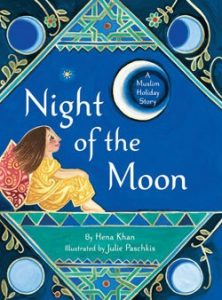 Night of the Moon: A Muslim Holiday Story
Night of the Moon: A Muslim Holiday Story
Written by Hena Khan
Illustrated by Julie Paschkis
Chronicle Books, 2008, 32 pp.
ISBN-13: 978-0-81186-062-8
There are approximately 1.6 billion Muslims worldwide, and 4.3 million Muslims of all ages living in the United States. This story offers a window into modern Muslim culture through a seven-year-old girl celebrating the Muslim holiday of Ramadan. Ramadan occurs during the ninth month of the Islamic lunar calendar. From the first light of dawn until the sun goes down, Muslims do not eat or drink anything. Time is instead spent with family, doing good deeds, in spiritual reflection focusing on God and becoming a better person.
The amazing illustrations evoke Muslim artists, imbuing the text with even more meaning. This story can provide insight for non-Muslim children who want a better understanding of the origins and customs of Ramadan. The book presents Islam in a comprehensible way told through a child’s perspective. Also, through the inclusion of Arabic words (with a glossary at the end) the reader can discover new vocabulary related to the Islamic faith. Overall, this representation of Ramadan is reverent and respectful, as readers discover traditions like feasting nightly with family and friends, religious symbols such as the night sky (crescent moon and stars), hands in prayer, and the temple.
Titles that pair well with the text to learn more about Ramadan are Magid Fasts for Ramadan by Mary Matthews (1996) and Celebrating Ramadan by Diane Hoyt-Goldsmith (2001). Under the Ramadan Moon by Sylvia Whitman and Sue Williams (2008) and Moon Watcher: Shirin’s Ramadan Miracle by Reza Jalali and Anne Sibley O’Brien (2010) are similar to Night of the Moon in that they use nighttime colors and the symbols of the stars and crescent moon. The Last Night of Ramadan by Maissa Hamed and Mohamed El Wakil (2007) is a good companion on the traditions and factual representations of Islam.
Author Hena Khan is a Pakistani-American Muslim born and raised in Maryland who enjoys sharing and writing about her culture and religion. She is an avid reader and always had a book in her hands as a child. Hena Khan has written many other stories from spies to space travel. In an interview about Night of the Moon, Khan stated: “For readers who practice the faith, my hope is that they feel represented and see their lives reflected in my work. I didn’t have books with characters that looked like me, had names like mine, or who celebrated my holidays when I was growing up.” Khan’s goal in writing her book is for readers to acknowledge the Muslim core values of community, family, charity, as the same ones shared by all people in the U.S.
In an interview, Julie Paschkis, the illustrator of the book, reveals that she did not know much about Ramadan before illustrating the book, but loved learning. She liked the way the story celebrated family through the Ramadan holiday. She used the theme of tiles to tie the book together visually. She also picked the color theme from the tiles: beautiful turquoise, cobalt and indigo blues with rust and gold for accents. Julie Paschkis has illustrated many books. She lets the words determine the style of art. The book Glass Slipper, Gold Sandal: A Worldwide Cinderella by Paul Fleischman (2007) has a similar richly patterned feel. She loves putting colors next to each other and telling stories with pictures.
Rachel de Oliveira, Texas Woman’s University, Plano, TX
WOW Review, Volume IX, Issue 1 by Worlds of Words is licensed under a Creative Commons Attribution-NonCommercial-ShareAlike 4.0 International License. Based on work at https://wowlit.org/on-line-publications/review/ix-1/
